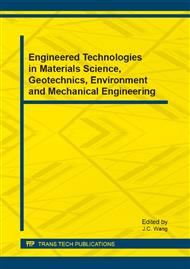[1]
W.R. Jiang, W.W. Zhou and H.C. Jia, "The potential of global offshore oil and gas exploration and its utilization prospects," Natural Gas Geoscience, vol. 21, 2010, pp.990-991 (in Chinese).
Google Scholar
[2]
L.F. Xiao, J.M. Yang and X. Li, "Shallow water effects on surge motion and load of soft yoke moored FPSO," China Ocean Engineering, vol. 21, 2007, pp.187-190.
Google Scholar
[3]
M. Ozger, Z. Sen, "Prediction of wave parameters by using fuzzy logic approach," Ocean Engineering, vol. 34, 2007, pp.460-462.
Google Scholar
[4]
M.A. Tayfun, F. Fedele, "Wave-height distributions and nonlinear effects," Ocean Engineering, vol. 34, 2007, pp.1631-1649.
DOI: 10.1016/j.oceaneng.2006.11.006
Google Scholar
[5]
D.C. Zhang, W.Y. Tang, S.K. Zhang, "Time-variant reliability analysis of FPSO hull girder considering corrosion based on statistics," China Ocean Engineering, vol. 21, 2007. pp.197-205.
Google Scholar
[6]
G. Yan, Y. Gu, "Effect of parameters on performance of LNG-FPSO offloading system in offshore associated gas fields," Applied Energy, vol. 87, 2010, pp.3393-3400.
DOI: 10.1016/j.apenergy.2010.04.032
Google Scholar
[7]
Z.Q. Hu, J.M. Yang, Y.N. Zhao, G. Bai, "Full scale measurement for FPSO on motions in six-degrees of freedom and environmental loads and deduction of mooring system loads," SCIENCE CHINA Physics, Mechanics & Astronomy, vol. 54, 2011, pp.26-34.
DOI: 10.1007/s11433-010-4200-1
Google Scholar
[8]
B.J. Kim, J.Y. Yoon, G.C. Yu, H.S. Ryu, Y.C. Ha, J.K. Paik, "Heat flow analysis of an FPSO topside model with wind effect taken into account: A wind-tunnel test and CFD simulation," Ocean Engineering, vol. 38, 2011, pp.1130-1140.
DOI: 10.1016/j.oceaneng.2011.05.004
Google Scholar
[9]
C.Y. Song, J. Lee, J.M. Choung, "Reliability-based design optimization of an FPSO riser support using moving least squares response surface meta-models," Ocean Engineering, vol. 38, 2011, pp.304-318.
DOI: 10.1016/j.oceaneng.2010.11.001
Google Scholar
[10]
L.X. Xiang, J.J. Zhuang, S.T. Tang, Y.K. Zhang, B.Y. Qian, Y. Wang, B.Q. Ma, Y. Tu, "The launch of the block in the bottom of a floating drilling storage and offloading unit and its rotational hull-erection," CN 200910028988.1, 2010 (in Chinese).
Google Scholar


